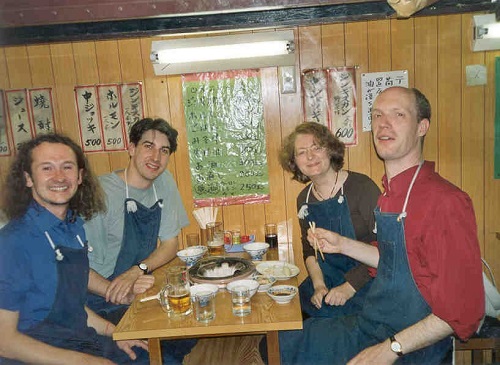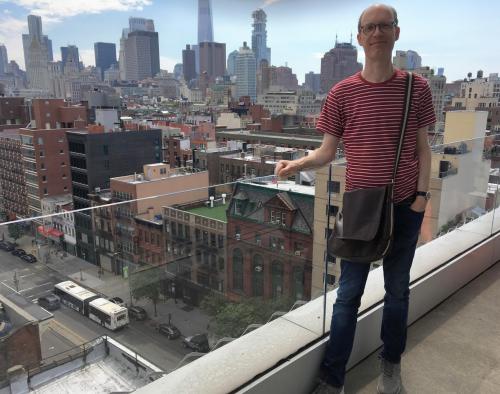Stanford University has recently released a list that represents the top 2% of the most-cited scientists in the world in various disciplines. A total of 1413 Belgian scientists have made it into this world ranking, with 9 of them listed in the top 10 in their research field. One of the researchers who made it onto the list is from BIRA-IASB! Jean-François Müller is, according to the Stanford ranking, the 6th most-cited scientist in the field of Meteorology and Atmospheric Sciences in Belgium, and the 984th out of 54.940 in the world (note that these 54.940 atmospheric researchers are already in the top 2% worldwide). We were curious to know what got Jean-François to this remarkable point in his life and career, so we decided to ask him a little about it. He gave us an honest and fascinating look into his life as a scientist.
Why did you choose scientific research as a career?
I was irresistibly attracted by the Big Bang, pulsars and other black holes ! And I wasn’t bad in mathematics. The choice of studies was quickly made…
How did you become an atmospheric scientist at the Royal Belgian Institute for Space Aeronomy?
I was very lucky! After studying Physics at the Université Libre de Bruxelles (ULB), not knowing what I wanted to do, I opted for an extra year of study: a special Licence in Geophysics. One of the teachers was Guy Brasseur, a BIRA-IASB alumnus. Guy was looking for a PhD student to work on the modelling of tropospheric chemistry. Not just anywhere: at the National Center for Atmospheric Research (NCAR) in Colorado, one of the most renowned research centres in the field. A grant from the FNRS was applied for, and obtained. So, I was fortunate enough to complete my PhD under the best conditions, dividing my time between the Belgian Institute for Space Aeronomy and NCAR, where I was able to rub shoulders with top researchers. Guy had made a name for himself in the modelling of the stratosphere. Given the growing importance of the problems of pollution and climate change, the troposphere needed to be tackled. My mission was therefore to develop a prototype of a three-dimensional global model of tropospheric chemistry. An exciting challenge, because it was multidisciplinary! This prototype became the IMAGES model, itself a precursor of the MOZART model. My first task was to draw up a global inventory of pollutant emissions on a latitude-longitude grid, something new at the time. I can still remember going round the embassies of major countries in Brussels to find information on polluting activities and their location... The Internet as we know it now did not exist at the time! I feel like I am speaking of prehistoric times.
After my thesis, completed in 1993, I continued this research at BIRA-IASB, in collaboration with NCAR, first under various contracts (thank you Dominique) and as a FNRS fellow, then as a statutory fellow from 1998.
Looking back on all your past research activities, what are the moments that have marked you personally?
What counts is the people you meet, the people you choose to work with. Research cannot be done alone. I already mentioned Guy and others at NCAR, but I must also mention Jef Peeters, a theoretical chemist from the University of Leuven, who gave me a taste for exotic and unexpected chemical mechanisms. In addition to his rigour and his ability to connect seemingly unrelated pieces of information, it was his passion which above all that made a great impression on me. The leitmotiv of our work together for almost 20 years is that the classical description of atmospheric phenomena (the one found in books) exists only to be overturned and renewed. Even if this sometimes requires a lot of patience, and even if most of the new ideas turn out to be wrong. I dare to believe that, thanks to Jef, I have contributed a little to shaking up and renewing certain preconceived ideas about the atmospheric chemistry of organic compounds.

Fabien Darrouzet, Manu Capouet and Jenny Stavrakou.
Credit: Jean-François Müller
And then, there are also my colleagues in atmospheric modelling at BIRA-IASB, who motivate me enormously with their commitment and mentality. The atmosphere (no pun intended) in the team is excellent. This is largely due to the generosity and determination of my colleague Jenny Stavrakou, with whom I have been working for almost 20 years. Jenny and I have developed new methods for exploiting observational data on chemical composition based on our global tropospheric chemistry model. Armed with these tools, we are trying to 'convert' satellite observations of different pollutants into emission data for these pollutants. To tell you the truth, I initially had many doubts about this kind of method, because of the inevitable biases in the observations and in the models, which are difficult to take into account. There is no miracle solution... However, we have been able to show the obvious value of this approach on several occasions, for example when we identified and quantified a major source of formic acid due to the degradation of hydrocarbons released by tropical and boreal forests.
What do you consider the best and worst aspects of scientific research (in your field)?
Many scientists will say that bureaucracy is the worst plague on research. Others will cite hierarchy, funding difficulties... There is some truth in this, but frankly, we get used to it. No, the worst thing for me is personal conflict, the one that strikes suddenly without you seeing it coming, and which you cannot solve. That is the worst. Fortunately, it is rare.
As for the best, I am (fortunately) spoiled for choice: the freedom we have to direct our research in directions we find interesting (ignoring the trends of the moment); celebrating a success with colleagues, even minor ones such as a positive review for an article, or major ones such as the conclusion of a doctoral thesis; a code that finally runs after weeks of being stuck; or learning that a research team is undertaking a major laboratory study to explore the consequences of mechanisms we helped to propose. Need I point out that the best aspects weigh more than the worst?
What progress/results do you hope to see in your field of research in the coming years, or even a more distant future?
A great challenge will be the transmission of knowledge to a new generation. This task is all the more difficult as I like to continue doing as much research as possible myself. Another challenge is the obsolescence of our research tools, which will have to be replaced. With a small team, the options are limited given the complexity of modern modelling tools, which requires a long learning curve. Current research funding possibilities are not well suited to the acquisition of sufficient expertise to carry out this kind of conversion. It is not impossible, but it has to be done in time and with the right people... and with the funding that goes with it.
Besides your work, what is most important to you?
Music, fine cuisine (especially Italian), reading, cycling, the fascinating world around us, various people. Before Covid: holidays in Italy! Since then, I've become more of a cinephile (at home).
And if you had never become a scientist, what do you think you would have become?
I would have enjoyed being a historian, but I could never have become one. Bad memory, difficulties in learning languages. No, Physics was the only option for me.
Credit: Jean-François Müller
Credit: Jean-François Müller



